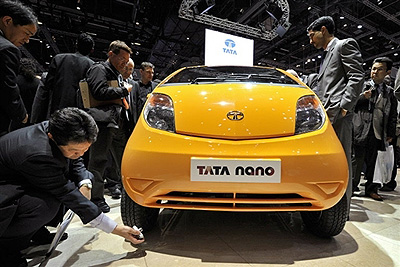This blog wasn't live back in December, when CAR became the first ever magazine to get a ride in a Tata Nano. While the Nano won't be sold in the States, it may be one of the world's most important green cars. Or is it even green at all? Well, that depends.
It's very small (a hair over 10 feet long), it has a tiny 624cc two-cylinder engine putting out 33 horsepower, and it has a catalytic converter to treat emissions. It's estimated to return about 48 miles per gallon, and emit just 100 to 120 grams of CO2 per kilometer, making it almost as fuel-stingy as ultra-efficient European diesels like the Ford Fiesta Econetic.

Tata Nano
Tata hopes to price it at only $2,500, and the company's goal is to make a "people's car" for India, in the vein of the Ford Model T, Volkswagen Beetle, and Citroen 2CV in their respective countries. Today, just 7 of every 1,000 Indians owns a car, and the World Bank says almost 7 motorcycles are sold there for every car.
Tata hopes to bring in the Nano at half the price of the Maruti 800, a 20-year-old design that is currently India’s cheapest new car--letting families who now travel five-up on a scooter make the leap to four wheels and four doors. If it can overcome early hurdles--not just cost pressure, but a relocation of its main factory--the Nano may achieve its goal of 1 million units a year.
The downside? In volume, the Nano could help swell the "global car park" from its current 800 million vehicles to as many as 3 billion by 2050. Visions of increased air pollution and monumental traffic jams led no less a personage than chief UN climate scientist Rejendra Pachauri to say the Nano gave him nightmares.
At the unveiling, Tata said Pachauri “need not have nightmares.” He noted that not only did the Nano meet all current Indian emissions standards, but in many cases, it would replace a two-stroke scooter with far worse emissions.
So what's it like? The CAR report said, "we’re pleased to be able to reassure that your Tata Nano will indeed drive like a proper car."
The basic Nano does without air conditioning, power steering, central locks, electric windows, a radio, even the sun visors, passenger side mirror, and a second windshield wiper. Its aluminum twin uses a balance shaft to cut vibration, and multi-point fuel injection with that catalyst to meet the Euro4 emissions limits.
CAR reports it will fit four 6-foot adults comfortably, the interior plastics were of "decent quality," and the ride was comfortable. Top speed is said to be about 60 mph, but CAR reported that the Nano ran out of steam above 40 mph (and one Indian auto executive said wheel bearings will wear out quickly above 45 mph). Not that it's a speed demon; with four adults on board, the reporter projected 17 seconds to reach 60 mph from a standing start.
Is it safe? The Nano forgoes the classic econobox layout set in 1959 by the BMC Mini: a transverse front engine and front-wheel-drive. Instead, its engine sits under the floor at the rear, eliminating pricey constant-velocity joints to power the front wheels. Removing the engine from the front of a small car actually improves crash safety, giving a deeper crush zone that deforms gradually without mashing a large lump of metal into the front passengers. The Nano has seat belts, but no airbags.
Tata has high hopes, including future US sales. Last summer, it bought Jaguar-Land-Rover from Ford--in retrospect, great timing for Ford but not so good for Tata. But if the company can get through the downturn, the Nano may catapult it into the ranks of truly important global players. CAR's verdict:
After experiencing it in action, we’re more convinced than ever of the transformational effect the Tata Nano could have on this industry.
[SOURCE: CAR Magazine]













